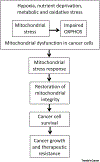Mitochondrial Stress Response and Cancer
- PMID: 32451306
- PMCID: PMC7392807
- DOI: 10.1016/j.trecan.2020.04.009
Mitochondrial Stress Response and Cancer
Abstract
Cancer cells survive and adapt to many types of stress including hypoxia, nutrient deprivation, metabolic, and oxidative stress. These stresses are sensed by diverse cellular signaling processes, leading to either degradation of mitochondria or alleviation of mitochondrial stress. This review discusses signaling during sensing and mitigation of stress involving mitochondrial communication with the endoplasmic reticulum, and how retrograde signaling upregulates the mitochondrial stress response to maintain mitochondrial integrity. The importance of the mitochondrial unfolded protein response, an emerging pathway that alleviates cellular stress, will be elaborated with respect to cancer. Detailed understanding of cellular pathways will establish mitochondrial stress response as a key mechanism for cancer cell survival leading to cancer progression and resistance, and provide a potential therapeutic target in cancer.
Keywords: cancer cell survival; cancer progression; heat shock protein 60; mitochondrial stress response; mitochondrial unfolded protein response; therapeutic resistance.
Copyright © 2020 Elsevier Inc. All rights reserved.
Figures




References
-
- Davis RT et al. (2020) Transcriptional diversity and bioenergetic shift in human breast cancer metastasis revealed by single-cell RNA sequencing. Nat Cell Biol 22 (3), 310–320. - PubMed
-
- Molina JR et al. (2018) An inhibitor of oxidative phosphorylation exploits cancer vulnerability. Nat Med 24 (7), 1036–1046. - PubMed
Publication types
MeSH terms
Substances
Grants and funding
LinkOut - more resources
Full Text Sources
Other Literature Sources
Medical
Research Materials
Miscellaneous

